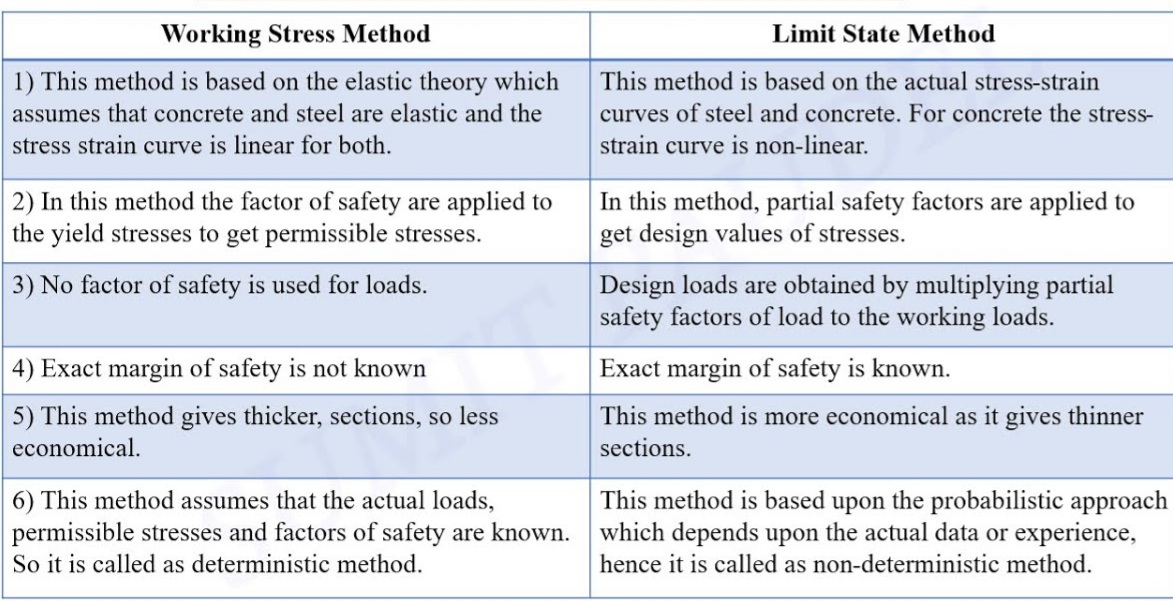
This article explains difference between working stress method and limit state method. The Working Stress Method and the Limit State Method are two methods used in the design of structures.
Working stress method is very rarely used nowadays. Limit state method is normally used for the design of high rise buildings.
Today, we will explore the key differences between these two methods and emphasize the importance of designing structures to be safe and reliable under all possible conditions.
The Working Stress Method assumes that a structure will not fail as long as the stresses generated in the material are within the permissible limits. The structural designer calculates the maximum permissible stresses for each material used in the structure and compares them to the actual stresses generated in the structure under the applied loads. If the actual stresses are within the permissible limits, the structure is considered safe and can be designed accordingly.
Limit State Method acknowledges the possibility of failure due to extreme loads or unforeseen conditions. This approach focuses on defining a set of limit states, or conditions under which a structure is considered to have failed, and ensuring that the structure is designed to resist these limit states. The principle underlying this method is that a structure is safe as long as it is designed to withstand all possible limit states.
One of the key differences between these two methods is the way in which they deal with uncertainty. The Working Stress Method assumes that the loads and materials used in the structure are known with a high degree of certainty. In contrast, the Limit State Method acknowledges that there is always some degree of uncertainty involved in the design process. This is reflected in the safety factors used in the two methods. The Working Stress Method uses a single safety factor for all loads and materials, whereas the Limit State Method uses different safety factors for different limit states.
Another difference between the two methods is the way in which they handle the design of structural elements. The Working Stress Method focuses on ensuring that the stresses generated in each element of the structure are within the permissible limits. In contrast, the Limit State Method focuses on designing each element to resist the specific limit states that are relevant to that element. This approach results in more robust and reliable structures, as it takes into account a wider range of possible failure modes.
The design of structures is a complex process that requires careful consideration of various factors. The Working Stress Method and the Limit State Method are two different approaches to designing structures. While the Working Stress Method is still used in certain cases, the Limit State Method is generally considered to be a more reliable and rigorous approach.
Regardless of which method is used, it is important to design structures to be safe and reliable under all possible conditions.
Working Stress Method Vs Limit State Method: WSM Vs LSM
| Aspect | Working Stress Method | Limit State Method |
|---|---|---|
| Basis of design | Elastic theory | Strength theory |
| Factor of safety | Higher factors of safety | Lower factors of safety |
| Load combinations | Loads are considered as a whole | Loads are considered individually and combined in prescribed ratios |
| Design strengths | Based on elastic limit of the material | Based on ultimate strength or yield strength of the material |
| Material behavior | Assumes linear elastic behavior | Considers both elastic and inelastic behavior of materials |
| Types of loads considered | Only dead load, live load, and wind load are considered | Consideration of various loads such as dead load, live load, wind load, seismic load, snow load, etc. |
| Design margin | Margin of safety is included in design equations | Margin of safety is not explicitly included in design equations |
| Design methodology | More simplistic and easier to understand | More complex and requires a deeper understanding of structural engineering principles |
| Design optimization | Difficult to optimize due to higher factors of safety | More optimization is possible due to lower factors of safety |
| Design accuracy | May not accurately predict the behavior of the structure | More accurately predicts the behavior of the structure |
| Use in practice | Still commonly used in simpler structures | Widely used in modern structural engineering design |
Faq
Working stress method or WSM.
Limit state method or LSM.
